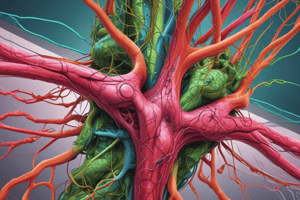Podcast
Questions and Answers
Which of the following best describes lymph's primary function within the lymphatic system?
Which of the following best describes lymph's primary function within the lymphatic system?
- Transporting gases to facilitate cellular respiration.
- Filtering fluid from tissues and transporting it back into the bloodstream. (correct)
- Actively pumping fluid like blood to maintain circulation.
- Directly initiating immune responses within the blood.
How does lymph fluid enter lymph capillaries?
How does lymph fluid enter lymph capillaries?
- Through overlapping epithelial cells that allow fluid entry. (correct)
- Through osmosis regulated by protein concentration differences.
- Through active pumping by the capillary walls.
- Through diffusion across a selectively permeable membrane.
What structural feature prevents the backflow of lymph within lymphatic vessels?
What structural feature prevents the backflow of lymph within lymphatic vessels?
- Smooth muscle contractions in the vessel walls
- Specialized valves located within the vessels. (correct)
- The narrow diameter of the lymphatic capillaries.
- The pressure gradient created by the heart.
How does lymph move through lymphatic vessels, given that it lacks an active pumping mechanism like the heart?
How does lymph move through lymphatic vessels, given that it lacks an active pumping mechanism like the heart?
What is the role of the capsule of connective tissue that surrounds lymph nodes?
What is the role of the capsule of connective tissue that surrounds lymph nodes?
What primary event occurs within the germinal centers of lymph nodes?
What primary event occurs within the germinal centers of lymph nodes?
How does lymph enter and exit lymph nodes, and what is the significance of this arrangement?
How does lymph enter and exit lymph nodes, and what is the significance of this arrangement?
Through which structures is lymph eventually returned to the cardiovascular system?
Through which structures is lymph eventually returned to the cardiovascular system?
What is the relationship between interstitial fluid and lymph?
What is the relationship between interstitial fluid and lymph?
Approximately what percentage of interstitial fluid diffuses back into blood capillaries, while the remainder enters the lymphatic vessels?
Approximately what percentage of interstitial fluid diffuses back into blood capillaries, while the remainder enters the lymphatic vessels?
What distinguishes lymph capillaries from blood capillaries in terms of structure?
What distinguishes lymph capillaries from blood capillaries in terms of structure?
The right lymphatic duct drains lymph from which part of the body?
The right lymphatic duct drains lymph from which part of the body?
The thoracic duct drains lymph from which part of the body?
The thoracic duct drains lymph from which part of the body?
If the efferent lymphatic vessels of a lymph node were blocked, what would be the most likely immediate consequence?
If the efferent lymphatic vessels of a lymph node were blocked, what would be the most likely immediate consequence?
What specialized tissues are found within lymph nodes to form its structure?
What specialized tissues are found within lymph nodes to form its structure?
Upon entering a lymph node through afferent vessels, lymph flows through the:
Upon entering a lymph node through afferent vessels, lymph flows through the:
What happens to lymph after it is filtered by lymph nodes?
What happens to lymph after it is filtered by lymph nodes?
Which characteristic is exclusive to the lymphatic system compared to the blood circulatory system?
Which characteristic is exclusive to the lymphatic system compared to the blood circulatory system?
Lymph nodes contribute to the body's defense mechanisms by:
Lymph nodes contribute to the body's defense mechanisms by:
What would indicate that the lymphatic system is functioning correctly?
What would indicate that the lymphatic system is functioning correctly?
Flashcards
What is Lymph?
What is Lymph?
A system of vessels working closely with the circulatory system. Clear, watery liquid formed in interstitial fluid.
Interstitial Fluid Balance
Interstitial Fluid Balance
About 90% of the interstitial fluid diffuses back into capillaries, while 10% enters the lymphatic vessels forming lymph.
Lymph Capillaries: Collection
Lymph Capillaries: Collection
Unlike blood vessels, they have dead ends. They are lined with overlapping epithelial cells, allowing fluid to enter and opening into large lymph vessels. Valves prevent backflow.
Lymph Movement
Lymph Movement
Signup and view all the flashcards
Lymph Node Structure & Function
Lymph Node Structure & Function
Signup and view all the flashcards
Two Large Ducts:
Two Large Ducts:
Signup and view all the flashcards
Lymph Summary:
Lymph Summary:
Signup and view all the flashcards
Study Notes
- Lymph is a system of vessels that works closely with the circulatory system.
- Lymph is a clear, watery liquid formed in interstitial fluid.
- As blood flows through blood vessels, some fluids leak into surrounding tissues.
- Approximately 90% of the interstitial fluid diffuses back into the capillaries.
- Around 10% of the interstitial fluid enters the lymphatic vessels.
- Interstitial fluid is renamed "lymph" when it enters a lymphatic vessel.
How Lymph Capillaries Collect Lymph
- Unlike connected blood vessels, lymph vessels have dead ends.
- Lymph capillaries are lined with overlapping epithelial cells that allow fluid to enter.
- These capillaries open into large lymph vessels.
- Valves within the vessels prevent the backward flow of fluid.
How Lymph Moves Through Lymph Vessels
- Lymph does not actively pump like blood.
- Surrounding skeletal muscles provide pressure to push the fluid along.
- Lymph vessels carry the lymph to lymph nodes, which are surrounded by a capsule of connective tissue.
Lymph Node Structure
- Trabeculae made of reticular fibers form the structure of lymph nodes.
- Inside lymph nodes, the germinal centers are areas of rapid mitosis.
- Immune cells are quickly produced to fight off invaders in the lymph.
- Lymph enters the lymph nodes through afferent vessels and exits via efferent vessels.
- Efferent vessels slow down lymph flow for filtration.
- Lymph is eventually returned through two large ducts within the chest:
- Right lymphatic duct
- Thoracic duct
Summary of Lymph
- Lymph is collected from interstitial tissues between cells.
- It squeezes into lymph capillaries and travels through larger lymph vessels.
- It is then filtered and returned to the cardiovascular system through ducts.
Studying That Suits You
Use AI to generate personalized quizzes and flashcards to suit your learning preferences.





